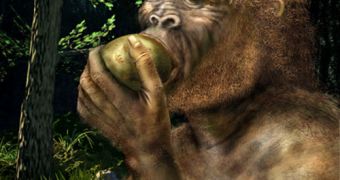Anthropologists believe that the earliest humans may have spent a lot more time eating millions of years ago then we do today. The reasons for this are multiple, and scientists say that teeth casts provide everything. In a new study, they compared such casts with those taken from other animals.
The records span back to the edge of dinosaurs, say scientists at the University of Arkansas in Fayetteville. The research was led by expert Peter Ungar, who is a distinguished professor and chairman of anthropology at the university.
He believes that eating was not as easy or as fast for our ancestors as it is for us. The conclusion is based on careful studies of numerous teeth, and the traits they share or that separate them.
The investigator is conducting his work in order to gain a better understanding of ancient diets. In other words, he wants to become acquainted to what and how much our distant ancestors ate.
In order to do this, the investigator must turn to a form of science that represents a mixture between dentistry, biology, engineering and anthropology. It's only through this integrated approach that he and his team can be sure they collected the correct type of information from the teeth casts.
“Our ancestors were large creatures. With very low quality foods, without cooked foods, it's very likely that they would have spent a great deal more of their day eating than we do,” Ungar explains.
The expert is currently using new investigations technologies to survey the surface textures of teeth belonging to species that are both alive today and extinct for tens of millions of years. The US National Science Foundation (NSF) is sponsoring his research.
“Typically, I will work with engineers, surface metrologists, people who study patterns of wear to develop technology for this 3D imaging of the teeth,” the team leader explains. He says that some of the teeth seem to reveal early humans did not always eat what they were adapted to eat.
One of the most interesting discoveries in the investigation is that, though adaptations for certain types of diets were there, they were not necessarily what early hominids used daily. Simply put, species of hominids featuring teeth that could crack nuts still preferred to eat soft fruit.
The fact that they were able to crack nuts was an adaptation for when there were no more fruits available anywhere. The same type of adaptation is visible in gorillas today.
“Paranthropus boisei has these very big, thick molar teeth with thickened enamel--very flat teeth, whereas the modern human has much smaller teeth, and somewhat thinner enamel,” Ungar adds.
“Some of these species have monstrously large teeth, they basically scream 'nutcracker.' These things are basically hammers and anvils for cracking nuts and other hard objects,” he says.
“When we look at the microscopic wear on those teeth, it's actually quite rare that we see the heavy pitting of a hard object eater. More often, they are sort of light, wispy scratches like you would find in a soft fruit feeder,” the expert concludes.

 14 DAY TRIAL //
14 DAY TRIAL //